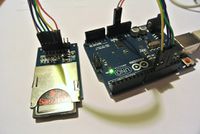133709 SD Card Module Slot Socket Reader For Arduino ARM MCU
Jump to navigation
Jump to search
A voir
- Library for Arduino https://github.com/adafruit/SD
- http://profmason.com/?p=1956
- http://www.jeremyblum.com/2011/04/05/tutorial-11-for-arduino-sd-cards-and-datalogging/
Arduino sketch
/*
* Log the value of the analog inputs in a data file
*
* Requires the SD library from the Adafruit website :https://github.com/adafruit/SD
*
*
* SD card attached MOSI - pin 11, MISO - pin 12, CLK - pin 13, CS - pin 10
* GND to GND pin - +5 to 5V
*
* @from http://profmason.com/?p=1956
*/
#include <SD.h>
const int chipSelect = 10;
const int NBLINE_BEFORE_FLUSH = 50;
const int PERIOD = 10; // period in ms between 2 acquisitions
#define LOGFILE_NAME "LOGGER00.CSV"
File dataFile;
void setup()
{
// Open serial communications and wait for port to open:
Serial.begin(57600);
while (!Serial) {
; // wait for serial port to connect. Needed for Leonardo only
}
Serial.print("Initializing SD card...");
// make sure that the default chip select pin is set to
// output, even if you don't use it:
pinMode(SS, OUTPUT);
// see if the card is present and can be initialized:
if (!SD.begin(chipSelect)) {
Serial.println("Card failed, or not present");
// don't do anything more:
while (1) ;
}
Serial.println("card initialized.");
// Open up the file we're going to log to!
// create a new file
char filename[] = LOGFILE_NAME;
for (uint8_t i = 0; i < 100; i++) {
filename[6] = i/10 + '0';
filename[7] = i%10 + '0';
if (! SD.exists(filename)) {
// only open a new file if it doesn't exist
dataFile = SD.open(filename, FILE_WRITE);
break; // leave the loop!
}
}
if (! dataFile) {
Serial.println("couldnt create file");
}
Serial.print("Logging to: ");
Serial.println(filename);
}
int i = 0; //Use this for the counter
void loop()
{
// make a string for assembling the data to log:
String dataString = "";
// read three sensors and append to the string:
for (int analogPin = 0; analogPin < 6; analogPin++) {
int sensor = analogRead(analogPin);
dataString += String(sensor);
if (analogPin < 5) {
dataString += ",";
}
}
dataFile.println(dataString);
// print to the serial port too:
//Serial.println(' ');
// The line dataFile.flush() will 'save' the file to the SD card after every
// line of data - this will use more power and slow down how much data
// you can read but it's safer!
// If you want to speed up the system, call flush() less often and it
// will save the file only when called and every 512 bytes - every time a sector on the
// SD card is filled with data. However, don't depend on the automatic flush!
i++;
if (i>NBLINE_BEFORE_FLUSH){ //Call every NBLINE_BEFORE_FLUSH times
dataFile.flush();
i = 0;
}
// Take 1 measurement every PERIOD milliseconds
delay(PERIOD);
}
